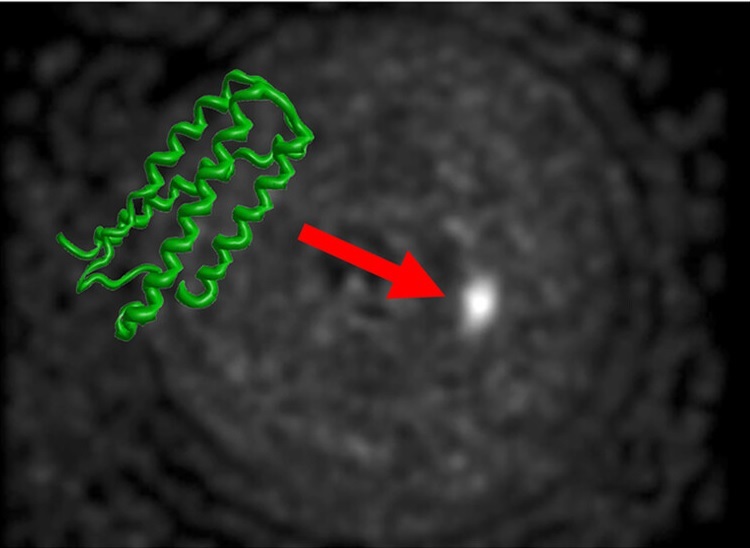Groundbreaking new research shines a light on the smallest proteins in real-time for the first time
November 21, 2023

Breaking new scientific ground, single unmodified proteins can now be observed and characterized in real-time without modifications, according to a new technique pioneered by Dr. Reuven Gordon’s team at the University of Victoria’s (UVic) department of Electrical Engineering.
“We can now see individual proteins in their raw state moving around whereas other methods require adding beacons to the proteins to see them,” explains Gordon. “Our technique is ultra-sensitive and we are able to see proteins four times smaller than what was previously possible. This is significant because existing methods cannot see half of the known proteins. Now we can and the implications are vast.”
Led by Gordon, the research team includes UVic PhD candidate Matthew Peters, who led the experiments, and imaging research collaborators Declan McIntosh and Dr Branzan Albu (ECE UVic); as well as biophysics expert Dr. Cuifeng Yang from the University of Nottingham Trent in the UK. Together, they have co-authored a new paper entitled “Label-free tracking of proteins through plasmon enhanced interference“ selected as an ‘editor’s choice’ in the current edition of the open access journal ACS Nanoscience Au. Peters will be presenting the team's latest results at the Single-Moleculle Sensors and nanoSysterms International Conference in late November 2023.
The team’s breakthrough is a culmination of more than a decade of research into the subject.
“We have been working on trapping proteins since 2011 and we could always see some noisy features in our camera data,” explains Gordon. “We started to see if we could dig out more information from this so-called ‘noise’ and were surprised to find clear trajectories of individual proteins moving around, even from the smallest proteins we attempted.”
Looking ahead, Gordon believes that the future applications and implications of the research are profound, potentially able to transform a wide range of scientific and medical fields.
“We can see this being applied to studying how proteins interact with each other and their environment and to observe their dynamics in real-time,” he explains. “This may answer some fundamental questions about life—there are 20,000 proteins in the human body that keep us alive and we really don’t know almost anything about how the body works at this level. Future applications can examine how to modify the interactions of proteins with prescription drugs, and be used to cure diseases, or to advance cancer therapies. Fundamentally what is exciting and unique here is that we are for the first time able to observe proteins without adding any labels or beacons to tether them to the surface. We are literally looking at the proteins themselves.”
Previous methods have required modifications to the proteins, potentially skewing both research results and real-world implications of such work.
“This is critical because almost all other approaches have to attach something to the protein or the protein to something, which fundamentally alters them and makes understanding their true nature impossible,” says Gordon.
Gordon is clear that their research success is a result of collaborative teamwork.
“Dr. Ying has collaborated with us and visited our lab and has expertise in the bio-related side of the his research,” he says. “Dr. Branzan Albu and her grad student Declan are experts in image processing. They gave us the tools we needed to do the important image analysis.”
Ongoing research is promising with demonstrations of being able to image 4 kDa proteins (among the smallest of proteins) and the use of high speed tracking with a 1600 fps camera indicating enough signal to potentially go faster. Looking ahead, Gordon said there is more research to be done and he and his team are already gearing up to advance, as well as to refine, their work.
“It is interesting that we can see the light scattering from such small particles. It should be nearly impossible to do so. So, there are clearly some aspects of the experiments that we still have to work to better understand -- there is still some hidden physics there that is exciting to uncover,” he explains. “We are very excited to apply this research to learn more about these protein nanomachines that power all life on earth. This ability to actually observe the protein prior to trapping and without modifying it in any way is a game changer in this field.”
Media contacts:
Dr. Reuven Gordon
Professor, Electrical and Computer Engineering
Faculty of Engineering and Computer Science
University of Victoria
Email: rgordon@uvic.ca
Tel : 250-472-5179
Ivan Watson
Communications Officer
Faculty of Engineering and Computer Science
University of Victoria
Email: engrcomm@uvic.ca
Tel: 250-418-0700
